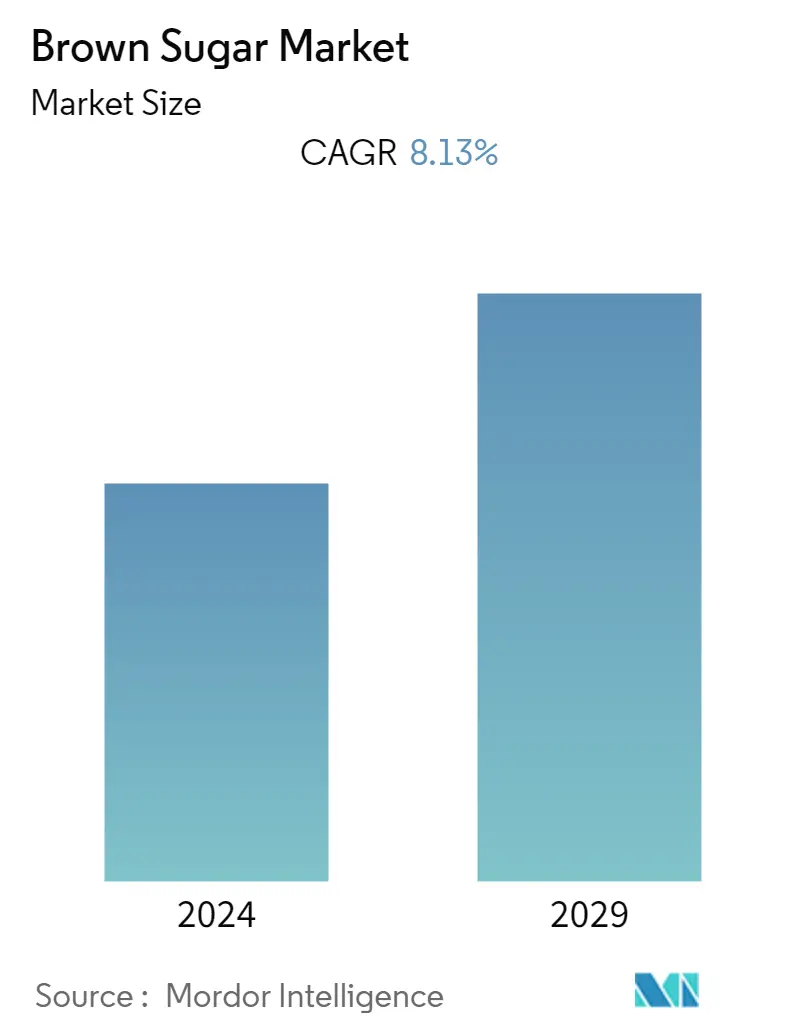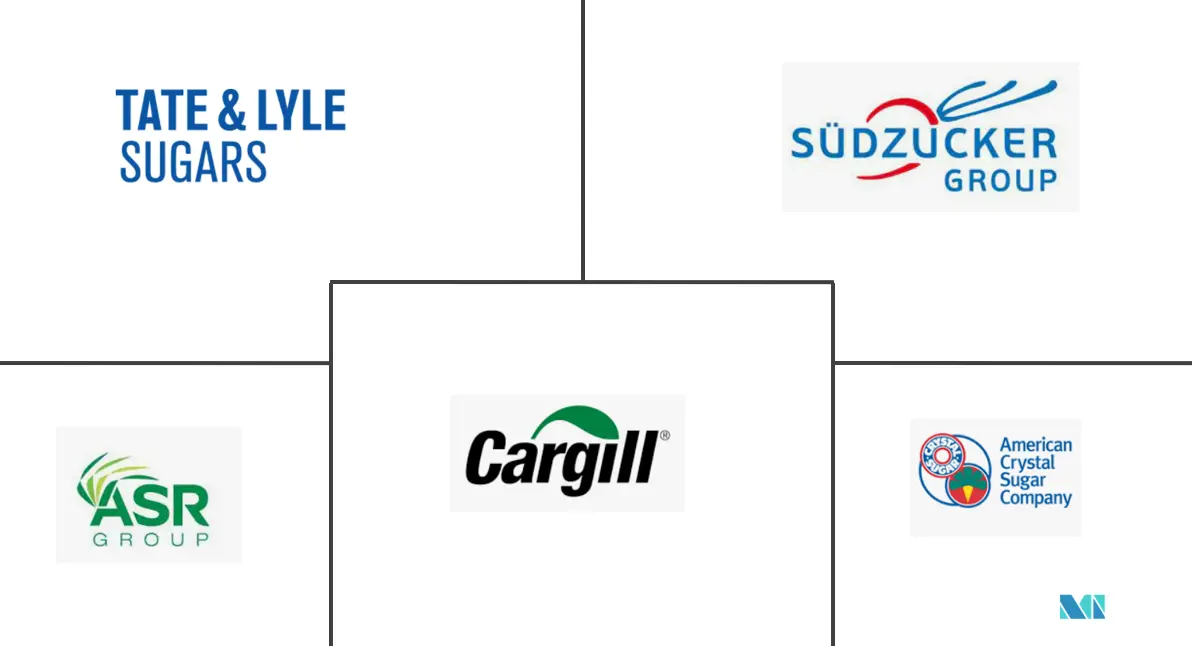Market Size of Brown Sugar Industry

| Study Period | 2019 - 2029 |
| Base Year For Estimation | 2023 |
| CAGR | 8.13 % |
| Fastest Growing Market | Europe |
| Largest Market | Asia-Pacific |
| Market Concentration | Low |
Major Players
*Disclaimer: Major Players sorted in no particular order |
Brown Sugar Market Analysis
The global brown sugar market is projected to register a CAGR of 8.13% over the next five years.
- The brown sugar market is growing with the rising demand from various sectors of the food and beverage industry. Therefore, it is anticipated that it will continue to increase over the coming years. White sugar crystals that have been sufficiently refined to allow precise control of the sugar crystal to molasses ratio and lower manufacturing costs are typically used to make brown sugar.
- The molasses in the brown sugar created in this manner may be easily separated from the crystals to produce white sugar, but it is frequently rougher than its unprocessed counterpart. There are several food-related applications for brown sugar, including dairy, baking, and other uses.
- As disposable incomes have increased in developed economies, there is a greater demand for upscale consumer products like baked products, enhancing their relevance to the food and beverage industry. The bakery industry prefers brown sugar over regular sugar due to its hygroscopic properties and the presence of molasses, which is anticipated to boost demand for brown sugar in the future.
- The rise of the health-conscious population, which is searching for healthier alternatives to white sugar, will also support the expansion of this market.
- Since brown sugar has been determined to be healthier than white sugar, customers may prefer brown sugar to white sugar, which would help this market grow over time. Organic brown sugar is produced by adding sugarcane molasses to completely refined white sugar crystals at the right proportion and ratio of molasses content. There are different types of organic brown sugar, and each of these types is redefined by a higher or lower molasses content.
Brown Sugar Industry Segmentation
Brown sugar is a sucrose sugar product that has a distinctive brown color due to the presence of molasses. It is either an unrefined or partially refined soft sugar consisting of sugar crystals with some residual molasses content, or it is produced by adding molasses to refined white sugar.
The brown sugar market is segmented by product type, form, application, and geography. Based on product type, the market is segmented into light brown and dark brown. Based on form, the market is segmented into powder, granules, and other forms. Based on application, the market is segmented into bakery and confectionery, beverages, dairy, and other applications. Based on geography, the study analyzes the brown sugar market in emerging and established markets worldwide, including North America, Europe, Asia-Pacific, South America, Middle-East and Africa.
For each segment, the market sizing and forecasts have been done on the basis of value (in USD million).
| By Product Type | |
| Light Brown | |
| Dark Brown |
| By Form | |
| Powder | |
| Granules | |
| Other Forms |
| By Application | |
| Bakery and Confectionery | |
| Beverages | |
| Dairy | |
| Other Applications |
| Geography | |||||||||
| |||||||||
| |||||||||
| |||||||||
| |||||||||
|
Brown Sugar Market Size Summary
The brown sugar market is experiencing significant growth, driven by increasing demand from the food and beverage industry, particularly in the bakery sector. This growth is fueled by the rising preference for healthier alternatives to white sugar, as brown sugar is perceived to offer more health benefits due to its molasses content. The bakery industry favors brown sugar for its hygroscopic properties, which enhance the quality of baked goods. As disposable incomes rise in developed economies, there is a growing demand for upscale bakery products, further boosting the market. The expanding indigenous bakery industry in developing regions, such as Asia-Pacific and Latin America, is also contributing to the market's expansion, as urban consumers increasingly seek out bakery items.
Asia-Pacific is the dominant region in the brown sugar market, supported by its tropical climate, which is conducive to sugar production. Countries like China, Thailand, and India are key producers, with Indonesia emerging as a significant exporter. The region's large customer base and demand for natural and organic food ingredients are driving market growth. The market is highly fragmented, with major players like American Crystal Sugar Company and Cargill Incorporated actively expanding their global presence through strategic partnerships and increased production capacities. Recent developments, such as the launch of locally produced brown sugar in Nigeria and sugar reduction technologies in Malaysia, highlight the industry's shift towards natural and functional food ingredients, reinforcing the market's growth trajectory.
Brown Sugar Market Size - Table of Contents
-
1. MARKET DYNAMICS
-
1.1 Market Drivers
-
1.2 Market Restraints
-
1.3 Porter's Five Forces Analysis
-
1.3.1 Threat of New Entrants
-
1.3.2 Bargaining Power of Buyers/Consumers
-
1.3.3 Bargaining Power of Suppliers
-
1.3.4 Threat of Substitute Products
-
1.3.5 Intensity of Competitive Rivalry
-
-
-
2. MARKET SEGMENTATION
-
2.1 By Product Type
-
2.1.1 Light Brown
-
2.1.2 Dark Brown
-
-
2.2 By Form
-
2.2.1 Powder
-
2.2.2 Granules
-
2.2.3 Other Forms
-
-
2.3 By Application
-
2.3.1 Bakery and Confectionery
-
2.3.2 Beverages
-
2.3.3 Dairy
-
2.3.4 Other Applications
-
-
2.4 Geography
-
2.4.1 North America
-
2.4.1.1 United States
-
2.4.1.2 Canada
-
2.4.1.3 Mexico
-
2.4.1.4 Rest of North America
-
-
2.4.2 Europe
-
2.4.2.1 United Kingdom
-
2.4.2.2 Germany
-
2.4.2.3 France
-
2.4.2.4 Russia
-
2.4.2.5 Italy
-
2.4.2.6 Spain
-
2.4.2.7 Rest of Europe
-
-
2.4.3 Asia-Pacific
-
2.4.3.1 India
-
2.4.3.2 China
-
2.4.3.3 Japan
-
2.4.3.4 Australia
-
2.4.3.5 Rest of Asia-Pacific
-
-
2.4.4 South America
-
2.4.4.1 Brazil
-
2.4.4.2 Argentina
-
2.4.4.3 Rest of South America
-
-
2.4.5 Middle-East and Africa
-
2.4.5.1 South Africa
-
2.4.5.2 Saudi Arabia
-
2.4.5.3 Rest of Middle-East and Africa
-
-
-
Brown Sugar Market Size FAQs
What is the current Brown Sugar Market size?
The Brown Sugar Market is projected to register a CAGR of 8.13% during the forecast period (2024-2029)
Who are the key players in Brown Sugar Market?
American Crystal Sugar Company, Sudzucker AG, ASR GROUP, Cargill Incorporated and Tate & Lyle Sugars are the major companies operating in the Brown Sugar Market.

